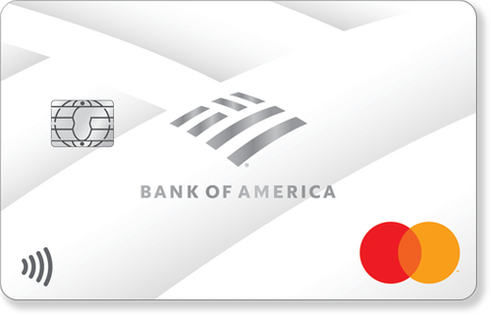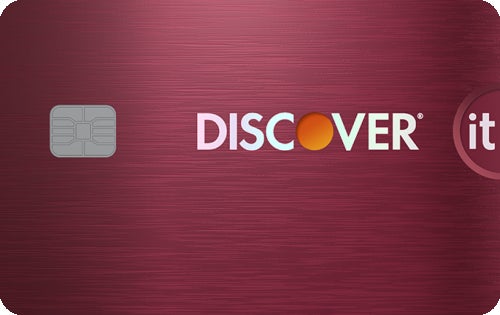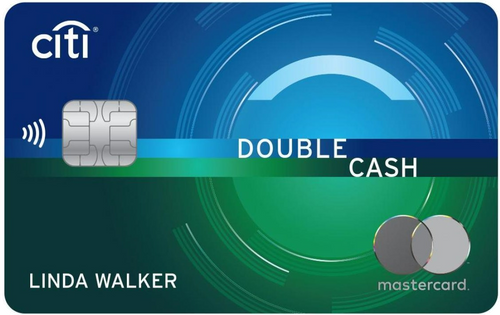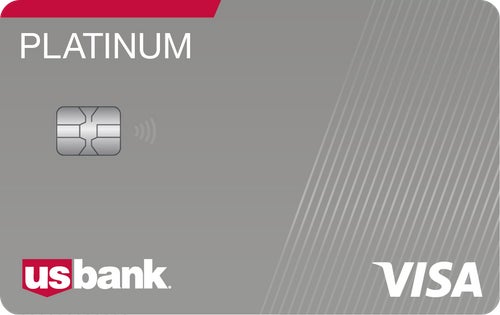| Balance Transfer Rating: | 4.3 / 5 |
| Introductory Offer | 4.0 |
| Rates & fees | 2.8 |
| Features | 1.0 |
| Issuer Customer Experience | 3.5 |
In a Nutshell:
The U.S. Bank Visa Platinum card offers cardholders with excellent credit a below average minimum interest rate and reasonable terms, including no penalty APR, and a long introductory period.
See Rates and Fees
0% Introductory Period |  |
Transfer Fee |  |
Introductory Purchase APR |  |
Regular APR 19.49% - 29.49% (Variable) |  |
Annual Fee |  |
U.S. Bank Customer Service Ratings
|  |
Other Notable Features: $600 cellphone protection ($25 deductible) and flexible payments
| Low Interest Rating: | 3.9 / 5 |
| Rates, Fees, Penalties | 3.3 |
| Rewards | 0.0 |
| Features | 1.0 |
| Issuer Customer Experience | 3.5 |
In a Nutshell:
The combination of a low APR and introductory offer make the U.S. Bank Visa Platinum card a good value for cardholders seeking to save money on interest.
See Rates and Fees
Regular APR 19.49% - 29.49% (Variable) |  |
Introductory Purchase APR |  |
Introductory Balance Transfer APR |  |
Fees
|  |
Penalties
|  |
U.S. Bank Customer Service Ratings
|  |
Other Notable Features: $600 cellphone protection ($25 deductible), auto rental insurance, flexible payments
If you’re struggling to pay off high-interest debt, transferring your balance to the U.S. Bank Visa Platinum card could get you some much-needed breathing room. Though its introductory APR period is not the highest available on a balance transfer credit card, it’s still a solid offer. But if you have a middle-of-the-road credit score or want a card with a robust rewards program, you should explore other options.
Why you might want the U.S. Bank Visa Platinum Card
If your top priority is getting a lot of time to pay off debt, this card is definitely worth considering, especially if you already have a banking relationship with U.S. Bank.
Long 0% introductory APR period on balance transfers
If you’re carrying a large balance on another card, odds are your interest charges are racking up quickly. By transferring your balance to the U.S. Bank Visa Platinum, you can get 18 billing cycles to pay it down while avoiding interest (a 19.49% - 29.49% (Variable) APR applies after that). And though you’ll need to pay a fee of $5 or 3% of your balance (whichever is higher), this is likely much less than the interest you’ll save over 18 billing cycles.
Here’s how the U.S. Bank Visa Platinum card’s balance transfer fee compares to the interest you’d pay if you carried a balance over 18 billing cycles/months, according to the CreditCards.com balance transfer calculator, assuming your APR is somewhere around average.
| Example balances | Cost of balance transfer fee (3% of balance) | Interest charged over 18 months if not transferred (18% rate) |
| $550 balance with $36 monthly payment | $16.50 | $79.42 |
| $2,200 balance with $145 monthly payment | $66 | $315.19 |
| $4,400 balance with $290 monthly payment | $132 | $630.38 |
Equally long intro APR on new purchases
In addition to a solid intro APR for balance transfers, the U.S. Bank Visa Platinum card offers an impressive intro period for new purchases. Cardholders get a full 18 billing cycles before they start accruing interest on new purchases (19.49% - 29.49% (Variable) APR thereafter).
This card can be a great option if you have a balance to pay down and also want to finance a large purchase over time without accruing interest charges. Just be sure not to charge more to the card than you can pay off in the first 18 billing cycles, especially if you are also paying down significant debt.
A handful of extra benefits
Though it doesn’t come with a rewards program, the U.S. Bank Visa Platinum card still includes some extra benefits that boost its value and could help you better manage your spending. Most notably, the card gets you:
- Cellphone insurance – Cardholders who pay their phone bill with the Visa Platinum can take advantage of the cellphone insurance benefit. In the case of damage or theft, they can receive coverage up to $600 ($25 deductible).
- Choose your own payment due date – To help you match your card payments to your schedule, you have the flexibility to choose your own due date.
- Fraud protection – You’ll be notified of any unusual card activity to stay a step ahead of credit card fraud.
- 24/7 account access – The U.S. Bank Mobile App makes it easy to visualize your payment, balance and transactions at any time.
- Free credit score – You’ll receive your TransUnion credit score on online banking and receive email alerts for any major changes to track your credit progress.
- Autopay – If you are worried about keeping track of payments, you can set up automatic payments each billing period.
While these are far from the most impressive perks available on a card that requires a good to excellent credit score, they could help you stay on track with your budget and keep tabs on your credit score.
Why you might want a different card
This card doesn’t include any sort of rewards program and its maximum ongoing APR is on the high side, so you might not get much long-term value out of it if you need to carry a balance beyond your intro APR period and don’t qualify for the best rate.
Some fees may be a deal-breaker
Though the U.S. Bank Visa Platinum card’s balance transfer fee is fairly standard in the current market (indeed, many cards charge a 5% balance transfer fee), it could still end up costing you, especially if you’re transferring a large balance.
If you are hoping to avoid this extra charge, you could search for a card with no balance transfer fee. While these cards are increasingly hard to find, there are still a few options out there, including the Navy Federal Credit Union Platinum card*.
That said, the trade-off for avoiding a balance transfer fee with this card is that it only gives you a 0% intro APR for 12 months on balance transfers (5.99% to 18.00% variable APR after that, offer expires Feb. 28, 2022). In a case like this, you’ll need to weigh the benefit of more time of 0% intro APR against the cost of transferring a balance with the U.S. Bank Visa Platinum card.
The U.S. Bank Visa Platinum card carries a few other fees you should keep an eye out for. These include an up to $41 fee for late payments and 2% to 3% (or $5, whichever is greater) on each foreign transaction you make (2% if the transaction is in U.S. dollars, 3% if in a foreign currency), making it a poor standalone choice if you spend much time abroad.
You’ll also be charged a $41 returned payment fee if your payment is returned. While all these are standard among credit cards, you can often find a balance transfer card with fewer surcharges. On the plus side, you won’t be charged a penalty APR, so you won’t have to worry about your rate skyrocketing if you make a late payment.
No rewards program
Unfortunately, the U.S. Bank Visa Platinum card doesn’t come with any sort of rewards program – limiting its long-term value. If you are hoping to continue to get extra value out of the card via rewards after the intro period ends, then it probably isn’t the best choice for you.
Alternatively, a handful of cash back cards, including the Citi Double Cash® Card and Discover it® Cash Back offer a generous cash back rate and a similar introductory period on balance transfers.
While rewards shouldn’t be your primary focus when you’re trying to pay off debt, opting for a balance transfer card that earns rewards could help you save on some of your everyday spending, and if the rewards program fits your spending habits, it could save you the trouble of applying for a new card after your intro APR offer ends.
Doesn’t have the greatest customer service reputation
When compared to other major issuers, U.S. Bank falls short when it comes to providing a great customer experience. In J.D. Power’s 2021 customer satisfaction survey, the bank scored 782, ranking below 90% of other major credit card issuers.
Carrying a balance long-term could be costly
If you do find yourself needing to carry a balance on this card at the end of the intro period, the APR is fairly reasonable, although not spectacular. Indeed, according to our card ratings methodology, though this card gets top marks for its balance transfer introductory offer, its low-end APR only warrants a middle-of-the-road rating.
Cardholders with the best credit can qualify for an APR as low as 19.49% variable – which is just above the average credit card APR for a balance transfer card. However, this low-end APR falls short of the rate offered by some dedicated balance transfer and low interest credit cards. The card’s APR can also range as high as 29.49% variable, which could add up quickly on larger balances.
Approval odds are slim without good credit
The U.S. Bank Visa Platinum card is designed for users with good credit to excellent credit (above 670), so you’ll want to ensure you meet those qualifications before you apply. If you have a low or middling credit score and are hoping to save on interest via balance transfer, you may have to look to other debt consolidation options.
Luckily, you can check if you prequalify for the U.S. Bank Visa Platinum card using the CreditCards.com CardMatch tool, which matches you to cards that fit your credit profile with no impact to your credit score. Simply enter a few bits of personal information and you’ll see a list of all the cards that suit your credit history.
Keep in mind, though, that balance transfer requests are approved independently of your card application – based on your allotted credit limit. You could theoretically be approved for the card but not have your balance transfer (or the full amount you’d like to transfer) approved. As such, if you have a larger balance to transfer, it is a good idea to wait to apply until you are higher in the range.
How does the U.S. Bank Visa Platinum compare to other cards?
Though the U.S. Bank Visa Platinum comes with a solid introductory APR available on both balance transfers and new purchases, it’s not the best offer on the market. If you are hoping for a chance at a lower ongoing APR, a longer intro APR or to earn rewards after you pay down your debt, one of these other popular options might be best for you.
 |  |  |
Rewards rate
| Rewards rate
| Rewards rate
|
Introductory period (balance transfers)
| Introductory period (balance transfers)
| Introductory period (balance transfers)
|
Introductory period (new purchases)
| Introductory period (new purchases)
| Introductory period (new purchases)
|
| Regular APR 16.24% - 26.24% Variable APR on purchases and balance transfers | Regular APR 18.74% - 27.74% Variable APR | Regular APR 18.49% - 28.49% (Variable) |
Other things to know
| Other things to know
| Other things to know
|
U.S. Bank Visa Platinum vs. Discover it® Cash Back
With a bit of legwork, the Discover it® Cash Back can be one of the most lucrative cash back cards on the market. It offers a whopping 5% back (on up to $1,500 in purchases per quarter, then 1%) after you enroll in one of several categories that rotate each quarter based on the Discover cash back calendar. Not only that, but it still carries a competitive intro APR offer. You’ll get 15 months to pay off a transferred balance or new purchases at a 0% intro APR, after which the ongoing APR is fairly low at 18.74% - 27.74% Variable APR. Discover also matches all the cash back you earn at the end of your first year, making the card a potentially very valuable option if you can pay off your balance during the 15-month introductory period.
U.S. Bank Visa Platinum vs. Citi Double Cash Card
Though it’s best known as one of the top flat-rate cash back cards on the market, the Citi Double Cash also carries a very competitive balance transfer offer. In addition to the up to 2% cash back you can earn on every purchase (1% when you buy, 1% when you pay off your purchase), you can enjoy a 0% intro APR for 18 months on balance transfers (a 18.49% - 28.49% (Variable) APR applies after that).
But on the downside, the Citi Double Cash does not carry an intro APR offer for new purchases. If you need to finance a larger purchase like a home renovation or car repair, the U.S. Bank Visa Platinum would be a better choice.
How to use the U.S. Bank Visa Platinum card:
- Make a plan to pay off your balance in the first 18 billing cycles to avoid accruing interest.
- Avoid charging more than you can pay off by the end of the introductory period.
- Pay for your cellphone bill with the card to take advantage of the protection.
Is the U.S. Bank Visa Platinum card right for you?
For cardholders dedicated to paying down a balance who are not worried about earning rewards after the intro period, the U.S. Bank Visa Platinum offers a good introductory offer on both balance transfers and new purchases.
That said, a fair number of other cards come with competitive intro APR offers on balance transfers, new purchases, or both, while also potentially carrying a lower ongoing APR and perks like a cash back rewards program. The trade-off with those will likely be the length of the intro APR period, so make a plan for paying off your balance and be realistic about how long it will take.
If you think you’ll need 18 months to make a significant dent, the U.S. Bank Platinum Visa is a great option. But if you have a smaller balance or can devote more resources toward repayment, you may be able to manage with a card that offers a shorter APR introductory period with better long-term value.
*All information about the Navy Federal Credit Union Platinum Card has been collected independently by CreditCards.com. The issuer did not provide the content, nor is it responsible for its accuracy.
Our reviews and best card recommendations are based on an objective rating process and are not driven by advertising dollars. However, we do receive compensation when you click on links to products from our partners. Learn more about our advertising policy
All reviews are prepared by CreditCards.com staff. Opinions expressed therein are solely those of the reviewer and have not been reviewed or approved by any advertiser. The information, including card rates and fees, presented in the review is accurate as of the date of the review. Check the data at the top of this page and the bank’s website for the most current information.
Responses to comments in the discussion section below are not provided, reviewed, approved, endorsed or commissioned by our financial partners. It is not our partner’s responsibility to ensure all posts or questions are answered.
